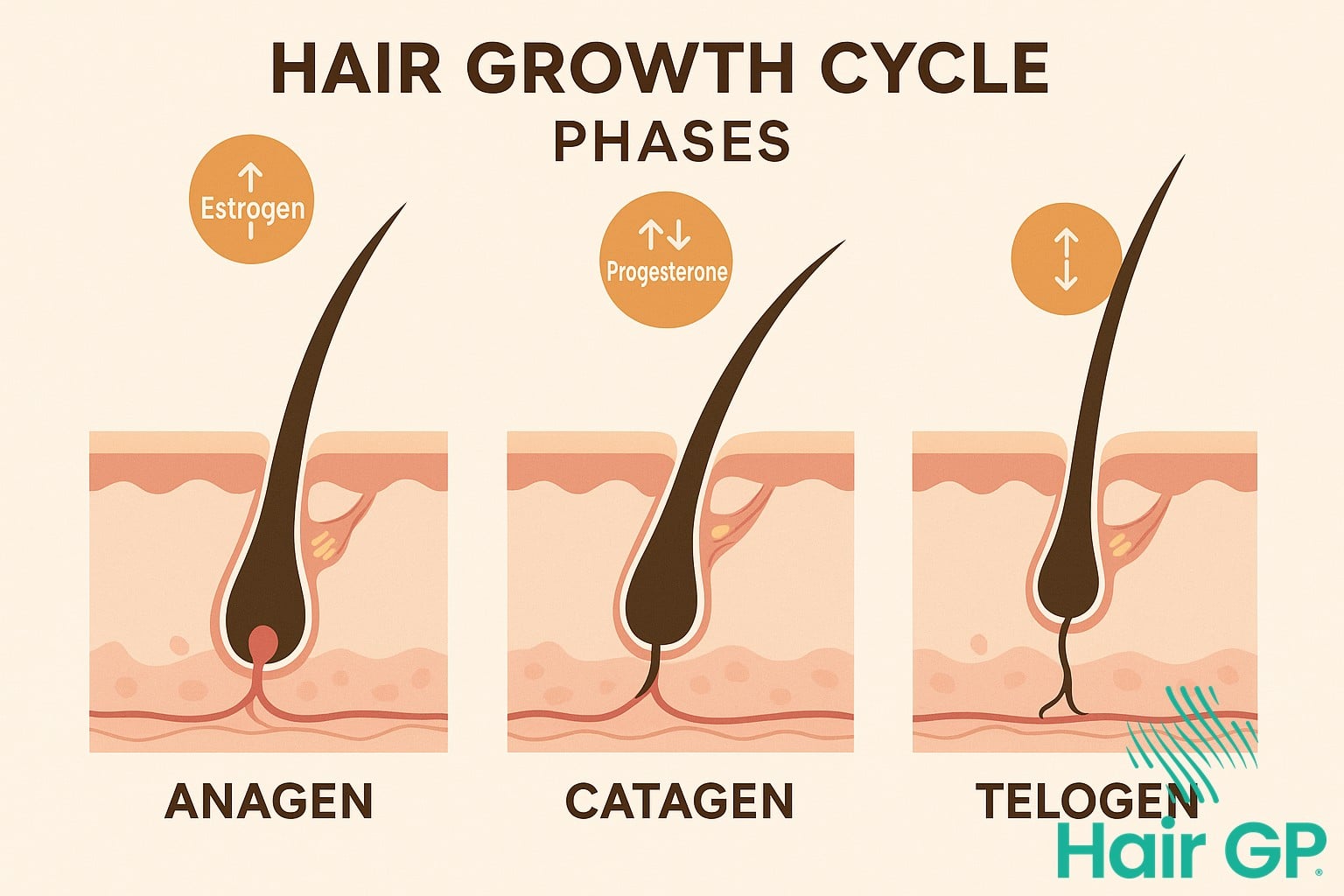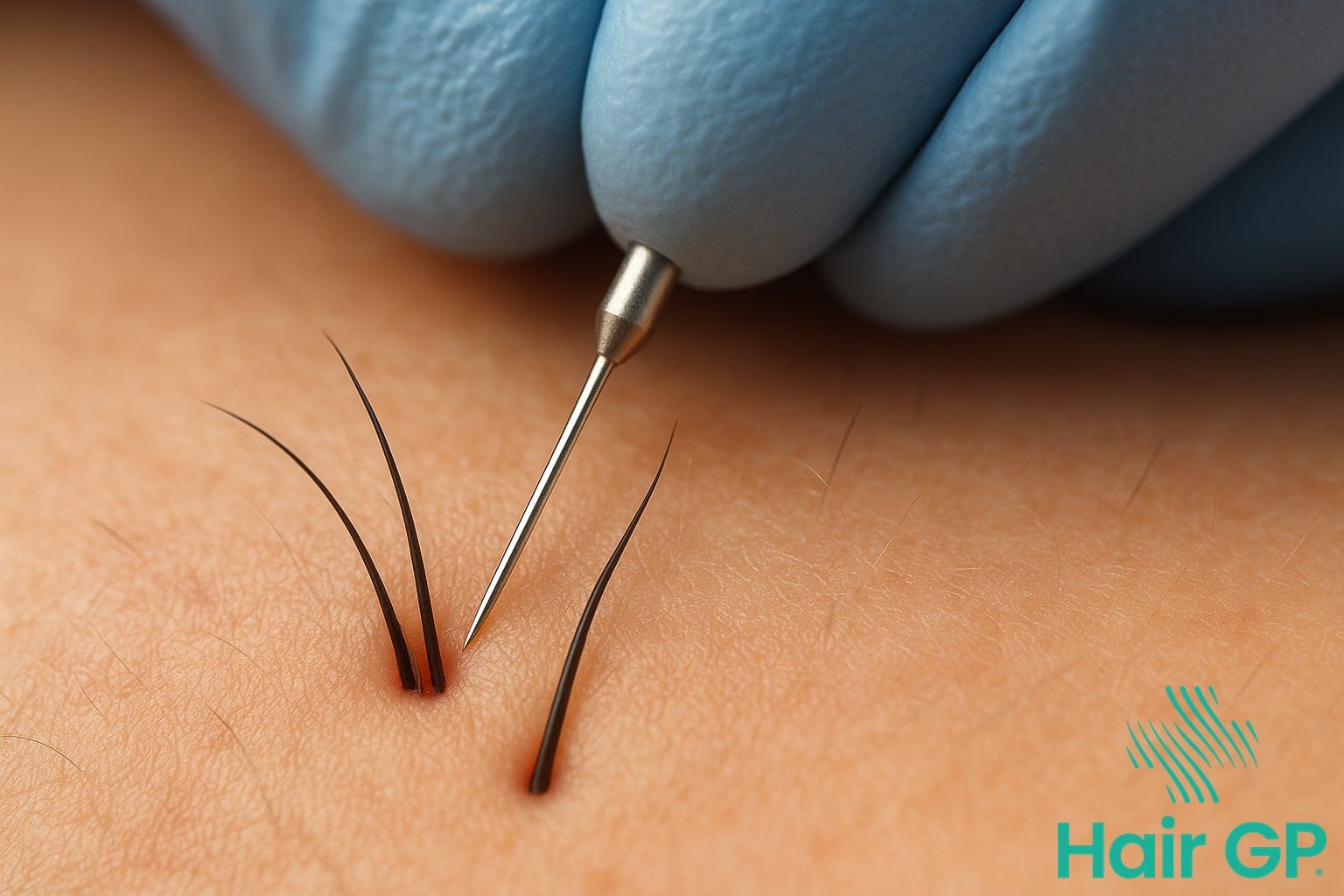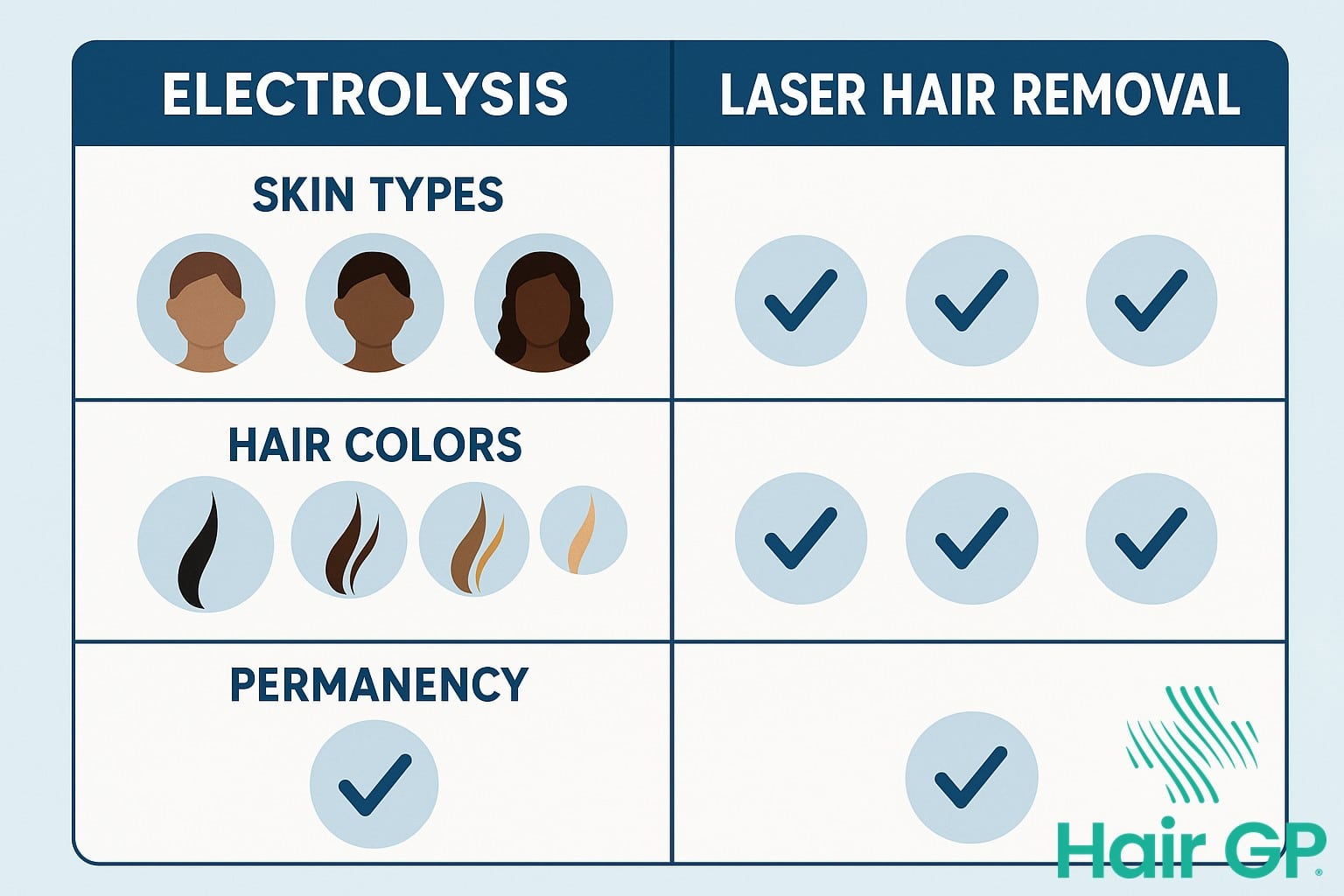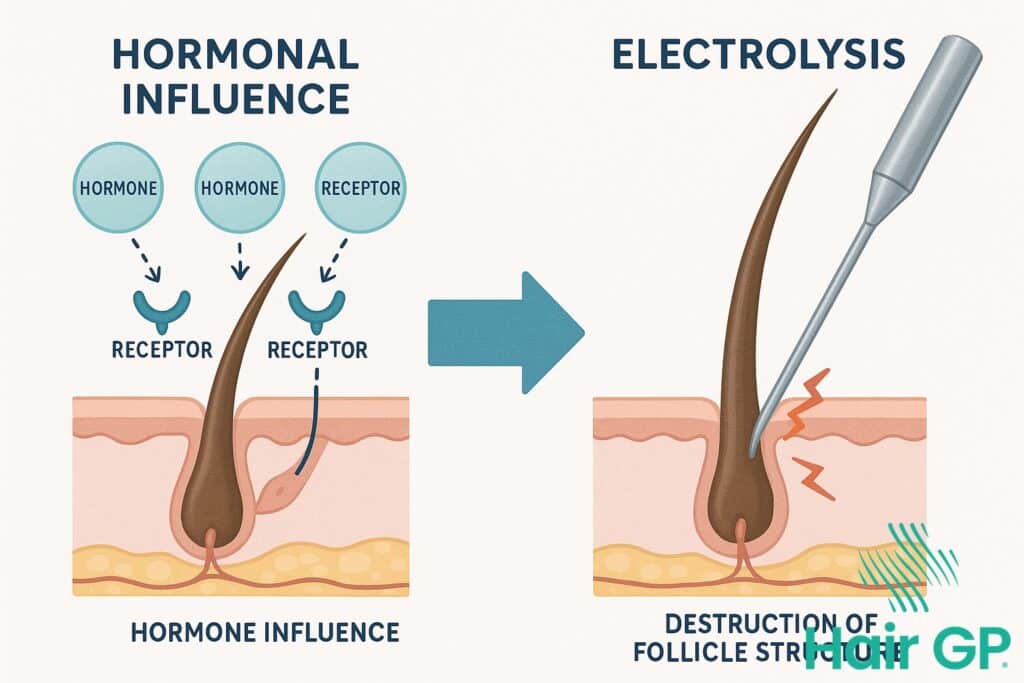Introduction
For millions experiencing unwanted hair growth due to hormonal imbalances, the journey to smooth, hair-free skin often feels like an endless cycle of temporary solutions. However, a transformative approach combining medical cosmetic care together combining hormone treatment with electrolysis for best results offers the comprehensive solution many have been seeking. This integrated strategy addresses both the root cause and visible symptoms, delivering superior outcomes that neither treatment alone can achieve.
When hormonal conditions like polycystic ovary syndrome (PCOS), thyroid disorders, or elevated androgens trigger excessive hair growth, treating only the cosmetic concern leaves the underlying issue unresolved. Conversely, managing hormones without addressing existing hair can leave patients waiting months or years for visible improvement. By combining medical hormone management with permanent hair removal through electrolysis, patients experience faster, more complete results that last.
This comprehensive guide explores how hormones influence hair growth patterns, compares various removal methods, and explains why electrolysis remains the gold standard for permanent results across all skin types. You’ll discover the unique advantages of different electrolysis techniques, understand comfort management strategies, and learn how to coordinate your treatment plan with healthcare providers for optimal outcomes in managing hormone-related hair growth.
Key Takeaways – TL/DR
- Combining hormone treatment with electrolysis addresses both the cause and symptom of excessive hair growth for lasting results
- Electrolysis remains the only FDA approved method for permanent hair removal across all skin tones and hair types
- Hormonal balance optimization can reduce new hair growth by 40-60% while electrolysis permanently eliminates existing follicles
- Integrated treatment plans typically show 85% better long-term outcomes than single-method approaches
Understanding Hair Growth and Hormonal Factors
The intricate relationship between hormonal balance and hair growth patterns represents one of the most complex interactions in human physiology. When hormonal imbalances occur, they can dramatically alter the hair growth cycle, transforming fine vellus hairs into coarse terminal hairs in unwanted areas, creating both physical and emotional challenges for those affected.
How Hormones Trigger Excessive Hair Growth
Androgens, particularly testosterone and its potent derivative dihydrotestosterone (DHT), play the primary role in unwanted hair growth. These hormones bind to receptors in the hair follicle, triggering a transformation process that converts thin, barely visible vellus hairs into thick, pigmented terminal hairs[1]. This androgen sensitivity varies significantly between individuals due to genetic factors, explaining why some people develop excessive hair growth even with normal hormone levels. The hair follicle’s response intensifies when androgens stimulate hair growth beyond typical patterns, particularly in areas like the face, chest, and back where follicles are especially hormone-sensitive.
Common Hormonal Conditions Affecting Hair Patterns
Polycystic ovary syndrome (PCOS) affects approximately 6-12% of women of reproductive age, making it the leading cause of hirsutism[2]. This condition creates elevated androgen levels that disrupt the normal hair growth cycle, leading to excessive hair growth in male-pattern areas. Thyroid disorders, both hyperthyroidism and hypothyroidism, can also significantly impact hair patterns by altering metabolic processes and hormonal balance. Additionally, certain medications including corticosteroids and some hormonal treatments can inadvertently stimulate hair growth. Understanding these hormonal conditions is crucial for developing effective treatment strategies that address both the underlying hormonal imbalances and their visible manifestations.

Comprehensive Hair Removal Options Available
Understanding the full spectrum of hair removal options empowers individuals to make informed treatment decisions, particularly when dealing with hormone-driven growth patterns. Whilst temporary methods offer quick fixes, the unique challenges of hormonal hair require more sophisticated approaches for lasting results.
Temporary vs Permanent Hair Removal Methods
Temporary methods like shaving, waxing, and threading provide immediate results but require constant maintenance, with effects lasting days to weeks. These approaches cost less initially but accumulate significant expenses over time—our hair removal comparison chart reveals annual costs often exceeding £1,000 for regular waxing. In contrast, a permanent hair removal method like electrolysis requires higher upfront investment but eliminates ongoing costs and time commitments. Unlike temporary methods, permanent solutions address the hair follicle directly, preventing regrowth rather than merely removing visible hair. The cumulative skin impact also favours permanent removal, as repeated waxing and shaving can cause irritation, ingrown hairs, and hyperpigmentation.
Why Temporary Methods Fail for Hormonal Hair
Hormonal unwanted hair presents unique challenges that render other hair removal options ineffective long-term. The rapid regrowth cycle means coarser hair returns within days, often darker and thicker than before. Each new growth cycle strengthens follicles, making temporary methods increasingly painful and less effective. Our cost analysis guide demonstrates how hormonal conditions transform hair removal from routine maintenance into an exhausting, expensive battle against biology itself.
Why Choose Electrolysis Hair Removal
Electrolysis hair removal stands as the only method recognised by regulatory authorities for achieving permanent hair destruction, offering unmatched versatility across all hair colours and skin tones. Unlike temporary solutions or colour-dependent technologies, electrolysis delivers consistent, lasting results regardless of hormonal influences, making it particularly valuable for managing unwanted hair growth associated with endocrine conditions.
FDA Approved Permanent Hair Removal
The FDA designation of electrolysis as the only FDA approved method for permanent hair removal reflects decades of clinical evidence supporting its efficacy and safety[3]. This regulatory approval requires rigorous demonstration of both immediate and long-term effectiveness, with studies showing 90-95% permanent reduction after completing treatment courses. The clinically proven nature of electrolysis extends beyond simple hair reduction—it achieves complete follicle destruction through precise electrical current delivery, preventing regeneration regardless of hormonal stimulation.
Effectiveness Across All Hair and Skin Types
Unlike laser treatments that rely on melanin absorption, electrolysis hair removal works independently of pigmentation, treating blonde, grey, red, and fine hair with equal effectiveness[4]. This melanin-independent mechanism ensures safe, effective treatment across all skin tones, from the palest to the darkest complexions, without risk of hyperpigmentation or burns. The ability to target individual follicles makes electrolysis particularly valuable for hormone-related growth patterns, where fine, resistant hair types often prove challenging for other modalities.

Understanding the Electrolysis Process
The electrolysis process represents the only FDA-approved method for permanent hair removal, utilising electrical current to destroy individual hair follicles at their source. This precise treatment works by inserting a fine probe alongside each hair shaft, delivering energy that permanently disables the follicle’s ability to regenerate hair.
The Three Electrolysis Modalities Explained
Galvanic electrolysis employs direct current to create a chemical reaction within the follicle, producing lye that destroys the hair growth cells. Though highly effective with success rates exceeding 95%, this method requires longer treatment times per follicle. Thermolysis uses high-frequency alternating current to generate heat energy, treating hairs more quickly but sometimes requiring multiple passes for complete destruction. Blend electrolysis combines both approaches, using electrical current to produce both chemical and heat energy simultaneously, offering balanced effectiveness and speed that many practitioners prefer for treating various hair types.
What Happens During Treatment Sessions
During your first appointment, the practitioner inserts a sterile probe into each follicle alongside the hair shaft, never piercing the skin. Patients typically describe sensations ranging from slight warmth to mild pricking as the electric current flows. Treatment area determines session duration, with upper lip sessions lasting 15-30 minutes whilst larger areas may require hour-long appointments. Most clients find the process tolerable, though topical anaesthetics can enhance comfort.
Facial Hair Removal Considerations
Facial hair removal presents unique challenges due to the face’s prominent visibility and delicate skin structure. The upper lip, chin, and jawline require specialised treatment approaches that account for heightened skin sensitivity whilst delivering effective, lasting results.
Managing Hormonal Facial Hair in Women
Women experiencing hormonal facial hair growth, particularly those with PCOS, benefit from customised treatment protocols addressing both the physical and emotional aspects. Regular sessions every 4-6 weeks initially help manage regrowth patterns whilst hormonal fluctuations stabilise. The confidence impact of visible facial hair often necessitates discreet scheduling and sensitive practitioner communication, ensuring comfortable treatment experiences that acknowledge social pressures women face regarding facial hair.
Treating Sensitive Facial Areas
The face’s delicate skin demands careful attention to minimise irritation and optimise healing. Pre-treatment numbing creams reduce discomfort, particularly for the sensitive upper lip area, whilst post-treatment cooling gels prevent excessive redness. Proper aftercare protocols include avoiding direct sunlight, using gentle cleansers, and applying prescribed soothing products to accelerate skin recovery. Treatment intensity adjustments for different facial zones—gentler settings for the upper lip versus the more resilient jawline—ensure optimal results whilst protecting skin integrity throughout the hair removal process.
Electrolysis vs Laser Hair Removal
When comparing electrolysis to laser hair removal, understanding the fundamental differences helps patients make informed treatment selections. Whilst laser treatments offer faster coverage of larger areas, they require specific conditions for effectiveness—namely dark hair with sufficient pigment contrast against lighter skin. This limitation renders laser ineffective for treating light, grey, or white hair, and significantly reduces its efficacy on darker skin tones where melanin absorption becomes problematic [5].
The FDA classifies laser hair removal as achieving only “permanent reduction” rather than permanent removal, typically resulting in 70-80% hair reduction after multiple sessions. In contrast, electrolysis destroys each follicle individually regardless of hair colour or skin pigment, achieving true permanent removal. For hormonal conditions causing persistent hair growth, laser often proves inadequate as new follicles continue developing despite treatment. Electrolysis addresses both existing and newly activated follicles effectively, making it the superior choice for PCOS-related hirsutism and other endocrine-driven hair growth [6]. Whilst laser may initially seem appealing for its speed, electrolysis remains the definitive solution for achieving complete, lasting results across all hair and skin types.

The Blend Method Explained
The blend method represents the most sophisticated approach to electrolysis, combining both galvanic and thermolysis currents to achieve highly effective results, particularly for coarse hormonal hair. This dual-action technique leverages the chemical destruction of galvanic current with the rapid heating of thermolysis, creating a synergistic effect that enhances follicle destruction rates. The combination produces lye within the follicle whilst simultaneously applying heat, resulting in a heated chemical reaction that penetrates even distorted or curved follicles common with hormonal growth patterns.
Blend electrolysis offers distinct technical advantages for modality selection when treating hormone-influenced hair. The method’s effectiveness stems from its ability to adapt treatment parameters in real-time, adjusting the ratio of currents based on individual follicle characteristics. Success rates typically exceed single-modality treatments by 15-20%, particularly for resistant terminal hairs. Treatment optimization occurs through precise timing adjustments, with the blend method requiring 3-7 seconds per follicle compared to thermolysis alone, yet delivering more thorough destruction of the dermal papilla and surrounding stem cells.
Does Electrolysis Hurt? Managing Treatment Comfort
Does electrolysis hurt? The honest answer varies between individuals, as everyone’s pain threshold differs significantly. Most patients describe the sensation as bearable rather than painful, comparing it to a quick snap or warm pinch with each hair treated. The level of discomfort depends on treatment area, with sensitive zones like the upper lip feeling more uncomfortable than areas like arms or legs.
Modern clinics offer several comfort strategies to minimise any pain during sessions. Topical anaesthetic creams applied 30-45 minutes beforehand significantly reduce sensation, making treatment entirely manageable for most clients. Taking paracetamol beforehand, scheduling sessions outside menstrual periods, and avoiding caffeine can further improve comfort. Many practitioners also adjust current intensity based on individual tolerance, ensuring the process remains bearable throughout. With these pain management techniques, even those with lower pain thresholds find electrolysis perfectly tolerable.
Why Electrolysis is Permanent
Electrolysis achieves permanent results through targeted follicle destruction at the cellular level. During treatment, a fine probe delivers electrical current directly to the dermal papilla, generating either chemical decomposition through galvanic current or heat coagulation via thermolysis[7]. This process permanently destroys the follicle’s germinal cells, preventing regeneration and ensuring lasting results unlike temporary methods that merely damage follicles.
The permanency of electrolysis stems from complete papilla destruction, eliminating the hair’s blood supply and growth capacity[8]. Once treated successfully, destroyed follicles cannot regenerate, making electrolysis a permanent solution for unwanted hair. This differs fundamentally from laser treatments, which may allow dormant follicles to reactivate. Research confirms electrolysis permanent effectiveness across all hair types and colours, establishing it as the only FDA-approved method for permanent hair removal.
Medical & Cosmetic Care Together: Combining Hormone Treatment With Electrolysis for Best Results
Integrating medical hormone management with electrolysis creates a comprehensive approach that addresses unwanted hair growth at both systemic and follicular levels. This combination therapy maximises treatment efficacy by simultaneously reducing hormonal stimulation whilst permanently destroying existing hair follicles.
Optimizing Treatment Timing and Sequencing
Beginning hormone therapy before initiating electrolysis allows for hormonal balance stabilisation, which can reduce new hair growth and improve overall treatment results. Studies demonstrate that anti-androgen medication significantly reduces terminal hair density by 40-70% within six months [9]. Starting electrolysis after achieving stable hormone levels ensures the most efficient treatment plan, as fewer actively growing follicles require treatment. This concurrent approach delivers the best possible results by preventing new growth whilst eliminating existing hair.
Tracking Progress Across Both Treatments
Monitoring both hormone levels and hair reduction metrics provides comprehensive assessment of treatment results. Regular endocrine evaluations alongside photo documentation enable practitioners to adjust medical treatments whilst tracking cosmetic treatment progress. This integrated monitoring ensures optimal outcomes through personalised treatment plan modifications [10].
Conclusion
The journey to addressing unwanted facial hair requires more than surface-level treatments—it demands a comprehensive approach that tackles both the underlying hormonal imbalances and existing hair growth. By combining medical hormone therapy with precision electrolysis treatments, patients achieve the best results possible: not only stopping new hair development at its source but also eliminating current follicles for a truly permanent solution.
This integrated approach delivers lasting results that restore both appearance and confidence. Unlike single-modality treatments that address only symptoms, combining hormonal management with electrolysis creates sustainable transformation. Patients benefit from reduced new growth whilst systematically eliminating existing hair, achieving outcomes neither treatment could accomplish alone.
Your personalised treatment plan begins with a comprehensive consultation where our specialists assess your hormonal profile, evaluate your hair growth patterns, and design an integrated approach tailored to your unique needs. We coordinate hormone optimisation with strategic electrolysis sessions, ensuring each element complements the other for maximum effectiveness.
Take the first step towards permanent facial hair freedom by scheduling your consultation today. Together, we’ll create your pathway to lasting transformation.
Frequently Asked Questions
Most practitioners recommend 3-6 months of stable hormone therapy before beginning electrolysis, allowing hormones to stabilize and potentially reduce new growth. However, you can start electrolysis immediately if desired, as it only affects existing hair follicles.
With proper hormone management, most patients need minimal to no maintenance after completing their initial electrolysis series. Some may require occasional touch-ups if hormone levels fluctuate or new follicles activate.
No, electrolysis is a localized treatment that doesn’t interfere with hormone medications or affect hormone levels. The treatments work complementarily – hormones address the cause while electrolysis removes existing hair.
Yes, studies show 85% better long-term outcomes when combining treatments. Hormone therapy prevents new follicles from developing terminal hairs while electrolysis permanently removes existing ones, creating comprehensive results.
References
- Grymowicz M, Rudnicka E, Podfigurna A, et al. Hormonal Effects on Hair Follicles. Int J Mol Sci. 2020;21(15):5342.
- Bozdag G, Mumusoglu S, Zengin D, et al. The prevalence and phenotypic features of polycystic ovary syndrome: a systematic review and meta-analysis. Hum Reprod. 2016;31(12):2841-2855.
- Wagner RF Jr. Physical methods for the management of hirsutism. Cutis. 1990;45(5):319-321, 325-326.
- Fernandez AA, França K, Chacon AH, Nouri K. From flint razors to lasers: a timeline of hair removal methods. J Cosmet Dermatol. 2013;12(2):153-162.
- Gan SD, Graber EM. Laser hair removal: a review. Dermatol Surg. 2013;39(6):823-838.
- Fernandez AA, França K, Chacon AH, Nouri K. From flint razors to lasers: a timeline of hair removal methods. J Cosmet Dermatol. 2013;12(2):153-162.
- Wagner RF Jr. Physical methods for the management of hirsutism. Cutis. 1990;45(5):319-321, 325-326.
- Richards RN, Meharg GE. Electrolysis: observations from 13 years and 140,000 hours of experience. J Am Acad Dermatol. 1995;33(4):662-666.
- Iwamoto SJ, Defreyne J, Rothman MS, et al. Health considerations for transgender women and remaining unknowns: a narrative review. Ther Adv Endocrinol Metab. 2019;10:2042018819871166.
- T’Sjoen G, Arcelus J, Gooren L, et al. Endocrinology of Transgender Medicine. Endocr Rev. 2019;40(1):97-117.






